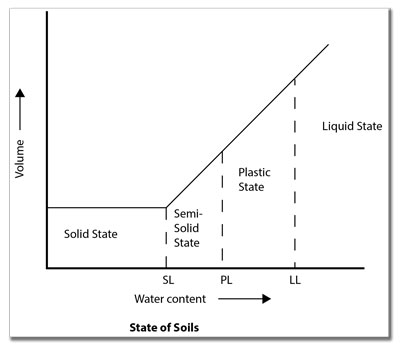Determination liquid limit and plastic limit for cohesive soils
INTRODUCTION
Atterberg limits :
The Atterberg limit is the measure of the critical water content of any fine-grained soil.
Mainly there are three Atterberg limits namely:
- Liquid limit
- Plastic limit
- Shrinkage limit
These limits help us to differentiate between the 4 states of soil i.e. solid, semi-solid, plastic and liquid and their behaviour in each of these states are different and are explained through these limits. The Atterberg limits are mainly used to distinguish between different types of silt and clay. The water content at which the soil changes from one state to another state is known as the Atterberg limit or consistency limit.

Graph depicting Atterberg limits
(Source: https://www.globalgilson.com/Content/Images/uploaded/blog/soils/state-of-soils-graph.jpg)
Liquid limit :
Liquid limit is the minimum moisture content at which the soil tends to flow like a liquid and which is, the arbitrary limit of the content of water at the point where the soil is just about to pass from the plastic state into the liquid state. At this state, the soil possesses a small value of shear strength, losing its ability to flow like a liquid.
It is important to know the stress history and general properties of the soil met with construction. From the results of the liquid limit, the compression index may be estimated. The compression index value will help us in settlement analysis. Suppose the natural moisture content of the soil is closer to the liquid limit. In that case, the soil can be considered as soft if the moisture content is lesser than the liquids limit. The soil is brittle and stiffer.
Liquidity index (IL) is the ratio of the difference between the natural water content and the plastic limit to the plasticity index.

( Source: https://1.bp.blogspot.com/-x7v3bO7pf5I/VuAjFkpEveI/AAAAAAAAED0/uPiHEuFRcCA/s1600/liquid%2Blimit.png )
Plastic limit:
Plastic limit is the water content where soil starts to exhibit plastic behaviour. A thread of soil that is at its plastic limit when it is rolled to a diameter of 3mm or begins to crumble. To improve consistency, a 3mm diameter rod is often used to gauge the thread's thickness when conducting the test.
Plasticity Index (IP) is the water content range within which the plastic properties of soil are exhibited; i.e. it is the difference between liquid and plastic limits.
IP = LL - PL
When the plastic limit cannot be determined, the material is non-plastic (NP). The plasticity index for sand is zero. For evaluating the plasticity properties of soil, it has been found desirable to use both the liquid limit and the plasticity index values.
Soil can be classified based on the liquid limit as follows:
| Liquid limit (%) | Compressibility |
|---|---|
| < 35 | Low |
| 35 - 50 | Intermediate |
| > 50 | High |
| Plasticity index | Soil type | Degree of plasticity | Degree of cohesiveness |
|---|---|---|---|
| 0 | Sand | Non-plastic | Non-cohesive |
| <7 | Silt | Low plastic | Partly-cohesive |
| 7-17 | Silt clay | Medium plastic | Cohesive |
| >17 | Clay | High plastic | Cohesive |
( Source: https://www.researchgate.net/figure/Types-of-soils-based-on-plasticity-index_tbl3_331920626 )
